
In each edition of Gimmick Some Lovin', we take a look at one iteration of a gimmick match available on the WWE Network. Some are iconic for their success, others for the extent to which they flopped, and some just... happened.
We defined a "gimmick match" as, in any way, adding a rule/stipulation to or removing a rule from a match, changing the physical environment of a match, changing the conditions which define a "win", or in any way moving past the simple requirement of two men/women/teams whose contest must end via a single pinfall, submission, count out, or disqualification.
This weekend, eagle-eyed fans spotted an announcement buried in official Wrestlemania 34 print materials: the subtle announcement that 1996 Olympian Mark Henry will be part of this year's WWE Hall of Fame Class. It's a well-deserved honour for the man who, 22 years ago, signed a gigantic promotional and talent deal with the World Wrestling Federation and has, in one form or another, been an employee of the company ever since.
Insane Vince McMahon ideas that got canceled - Watch Here!
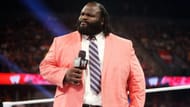
He's impregnated octagenarians, helped start the YES! movement, and held numerous titles, in addition to orchestrating one of the greatest John Cena sneak attacks in WWE history. He's also in the storied ranks of the 23 in 23-2 and, since that number looks to have gained a 24th in the aforementioned Dr. of Thugonomics this week, today we're looking at Mark Henry's attempt to put the Deadman to rest in Wrestlemania 22's casket match.
A Gimmick Love-Fest
Wrestlemania 22 is noteworthy for a lot of reasons.
First is the fact that it's the final Showcase of the Immortals to emanate from anything smaller than a 60,000-seat venue; starting with Wrestlemania XX, McMahon and company paid tribute to their early origins with a tour through some of the first cities to host Wrestlemania (and, of course, the areas which hosted the three-city Wrestlemania 2 debacle).
Beginning with New York City's Madison Square Garden (a go-to for major Wrestlemania anniversaries, a pattern broken by Wrestlemania XXX's Silver Superdome setting), then moving to Los Angeles (where Wrestlemania went Hollywood), and finally Chicago, WWE decided enough with the small venues (and their limited opportunity for ticket sales), returning to Detroit and its brand new Ford Field for the anniversary of their record-breaking Wrestlemania III show at the Pontiac Silverdome.
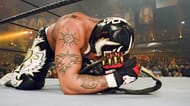
Further, the show saw Rey Mysterio capture the World Heavyweight Championship and become the smallest world champion in the history of any major North American wrestling company, defeating Randy Orton and Kurt Angle in a match dedicated to (and, had he not died, rumoured to have originally belonged to) the recently-departed Eddie Guerrero.
However, on the slides of this column, what we care about are the ridiculous, rule-changing, over-the-top spectacle matches, and that's where this card is truly special: of its eleven matches (twelve if the dark match is included in the count), eight meet the criteria for this column.
The show features a battle royal dark match, a Money in the Bank Ladder Match, the hardcore match pictured above, a handicap match, a no holds barred match (and, if you're looking for the distinction between it and the hardcore match, you may be in the wrong place), the triple threat that saw Mysterio cement his championship legacy, a Playboy Pillow Fight (which will never get time here, for lots of reasons), and today's match: the casket match.
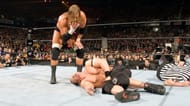
In fact, only four contests (three one-on-one matches for singles titles and a traditional two-on-two tag team championship match) were pure wrestling contests on the second-to-last Wrestlemania before the dawn of the PG era. Whether intending to give the show a bigger feel than its setting could provide, or simply to go as crazy as possible for their April spectacular, this show looked to bring the sports entertainment spectacle in spades.
The Build

We talked last week how WWE storytelling in February and March tends to marginalize tag team stories and add in as many plot wrinkles as possible to justify a multi-team spectacular on the Grandest Stage of 'Em All.
Another area where this haphazard storytelling rears its head is with the Wrestlemania opponent(s) of one Mark Callaway; while some matches have long, meaningful, and intriguing builds (and followups), a lot of them simply boiled down to "I want to beat the Undertaker's streak," especially once people realized Booger Red had a Wrestlemania streak and began capitalizing it in their marketing.
This match falls into the latter category, with Undertaker first being the victim of an irate Henry failing to capture the World Heavyweight Championship from Kurt Angle, and Henry then shifting his focus to becoming the ONE in 13-1.
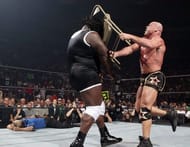
Henry had challenged fellow 1996 Olympian Angle at the Royal Rumble for Angle's Big Gold Belt and lost after Angle nailed Henry with a chair during a ref bump before a well-timed rollup for the three. Undertaker would challenge the reigning Smackdown champ Angle to a match, which ended in a disqualification when Henry interfered to prevent Undertaker from winning with the Tombstone Piledriver.
The rest of the build involved Henry putting Taker through the announce table with a World's Strongest Splash, Undertaker attacking Henry and his manager, Daivari, on Saturday Night's Main Event on, in, and around a casket, and numerous Henry allusions to "The Streak," which had just become storyline fodder the previous year with "The Legend Killer" Randy Orton referring to it in the build to his own Wrestlemania loss to The Phenom.
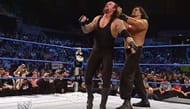
It was, essentially, what would become the usual Victim of the Year story; Undertaker would have far better programs entering Mania, but this one would join the likes of Bray Wyatt, Shane McMahon, CM Punk, and Roman Reigns as the "we need Undertaker to do something; who's available this year?" segments on pre-Wrestlemania television (although at least one of those matches would deliver mightily once the show came around).
The Rules
![[Paul Bearer voice] Dou-ouble deep! Dou-ouble wide!](https://staticg.sportskeeda.com/editor/2018/03/13e90-1521410215-800.jpg?w=190)
In a casket match, the corpse receptacle which gives the contest its name is present either at ringside or in the ring, and the only way to win is to place one's opponent inside the body box and close the lid fully; earlier variations included the bodybag match (which seemed to be a house show staple during Callaway's early WWF run), and the first casket match, where being put into the coffin was the result of being pinned (and Taker actually nailed Kamala's coffin shut, which makes this writer's claustrophobic nerves tingle).
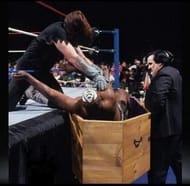
The casket itself tends to change depending on the man with whom Undertaker is feuding, and has included a personalized golden coffin for Goldust and a double-deep-double-wide (says Paul Bearer) monstrosity constructed for Yokozuna's massive frame.
The Match
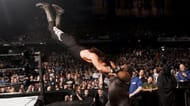
For starters, finding this in the Wrestlemania broadcast lets you sit through the heavily-edited end to Mickie James vs. Trish Stratus, and a McMahon family prayer summit in preparation for Vince's clash with Shawn Michaels, and nowhere is the stark difference between 2018 WWE and 2006 more apparent.
Druids straight out of your local pop-up Halloween store struggle to manoeuvre the casket down to ringside as generic chanting plays before Henry highlights just how great his Three-Six Mafia theme is by entering to generic sludgy nu-metal guitar riffs.
Undertaker is aided by the powers of fog, flame, and awful CGI lightning; the stark contrast here between entering Wrestlemania in a normal arena and his later stadium spectaculars is on full display. It's a great deal more than his usual pay-per-view entrances but doesn't feel Wrestlemania like his later productions would.
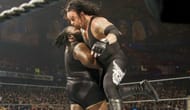
Henry attacks as Undertaker disrobes and controls with the generic big-man offence; Undertaker tries to knock the World's Strongest Man over but gets clotheslined, choked, and guillotined on the second rope for his efforts. The story is Henry controlling with heavy forearms, headbutts, and chokes, while Taker occasionally tries to gain control and fails mightily.
After blocking Henry's first attempt to put him in the coffin, Undertaker nails Old School on his second try but gets dispatched again with a Henry STO. The Hall of Pain tries another guillotine but slides directly into the casket, and the two men brawl there. The image of two 300+ pound men brawling in a casket is an interesting visual but doesn't provide the best wrestling action.
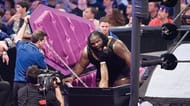
Undertaker attempts a flying cross body, which Henry counters with a World's Strongest Slam; Henry pulls a Tully Blanchard and forgets that pinfalls do not count before pushing Undertaker into the casket where the Deadman miraculously recovers.
Undertaker brings all of Chicago to its feet by improvising the Last Ride Powerbomb (albeit a sloppy one) to counter a ten-punch in the corner, then flies over the ropes, the refs, and the casket with a plancha to the floor before rolling Henry back into the ring for a Tombstone. It's academic at this point that Henry is rolled directly into the coffin at this point, which closes with no fight from Sexual Chocolate.
My Rating
This one is definitely a tale of two matches.
There's the early sequences, where Henry controls and tries to wear down his opponent, that seem to drag on endlessly. Those sequences tell the familiar "big man vs. smaller underdog" story that is really out of place here. Undertaker was the "little guy" in much of his mid-to-late 90s feuds, and those are forgotten for a reason. Much of the first eight minutes of this contest feels like a rehash of Undertaker vs. King Kong Bundy or Undertaker vs. King Mabel: punches, headbutts, chokes, and very little to really cheer for.
Then there's the final two minutes or so, the sequence which includes the Last Ride, the plancha, and the Tombstone. Those are the two minutes that really live up to a Wrestlemania billing, much of which I watched with my mouth agape (this Wrestlemania occurred during my final semester of college when I considered myself alternately either too cool or too busy to watch wrestling, so this was my first exposure to this match). That's the stretch of this match where the men in the ring were able to be the talented storytellers and oversized powerhouses they should have been for the match's duration.
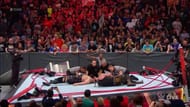
In recent years, big man vs. big man matches have shifted away from the plodding affairs of the 1980s and 1990s and into a far more exciting, spectacle-driven style; contests today featuring giants and super heavyweights far more resemble the closing minutes of this match than its opening. Things like Henry's championship feud with The Big Show and Braun Strowman's clashes with Show and Henry pack action, excitement, and brutality into their matches which make battles between giants must-see (as opposed to must-avoid, like contests such as Mabel vs. Yokozuna).
As early as the following year, WWE would already allow a Clash of the Titans to become a spectacle of brutality when Undertaker and Batista would have a fantastic hoss fight of their own, so WWE had the tools already to kick this one into gear. They simply seemed unwilling to let these men lose until the finishing sequence in Chicago.
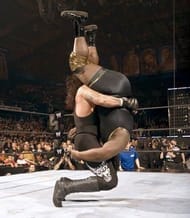
Those last two minutes are really fun but can't totally redeem the whole contest; it's strange that Henry is still billed as The World's Strongest Man but is unable to display his brute strength with any lifting offence against a man he could easily overhead press. Undertaker gets all of the strongman glory with his powerbomb and finisher, but Henry does very little here that's unique or fitting with his character and his billing as a punishing powerlifter.
In our first entry, we looked at an Undertaker match where the entirety of the contest is enjoyable until its final, plodding sequence, but this one is the exact opposite. The casket match sags and suffers under the considerable weight that it's unable to use to its fullest potential until those eye-popping final sights. They're good, but Henry should have had more opportunity to shine here, so we'll go 5/10 for, so far, the only casket match in Wrestlemania history.
Meltzer Says
Dave is significantly less excited about this Wrestlemania than Brendan Dassey was, and gives this match only a star and a half.
Send us news tips at fightclub@sportskeeda.com
Make Sportskeeda your preferred choice for WWE content by clicking here: Source preferences

